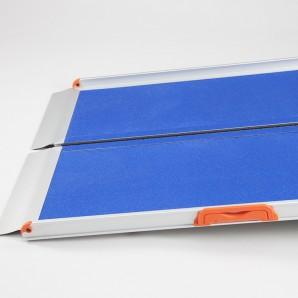79-year-old Helena has lived for 20 years with increasingly severe arthritis. It causes her constant her pain and stiffness all over her body. It is a challenge for her to move around at home but she finds certain equipment makes a big difference. She shares her experience of her key mobility aids in the hope that it might give ideas to others in similar situations.
Luckily for Helena, she has always lived in a single-floor bungalow. The pain in her hips makes climbing and descending stairs particularly uncomfortable, so her home suits her well. The only steps she needs to deal with are the two shallow ones up to her front door and one outside the back door to the garden.
For both of these fitting rails to the adjacent walls at around elbow height, has made a difference. Placing them here on a slant provides support exactly where required. These particular rails are specifically for outside use, so they will not corrode after getting wet in the rain. They have plastic textured surfaces which aid grip and do not feel icy cold even in the middle of winter. Helena has considered fitting mobility ramps to overcome the steps to the front door and garden, but has so far decided against it.
No More Furniture Surfing!
In her late 60s, Helena spent more than a year ‘furniture surfing’ around her home. This meant leaning on sideboards, the backs of chairs and other furniture to get support while moving around the house. Occupational therapists consider this to be dangerous, as you are likely to tip-up the furniture, potentially leading to a fall. For this reason, they strongly advise against it.
Around the house Helena now has grab rails in several strategic locations. Next to the toilet she has a white one fitted to match the tiles. There is also one inside the shower cubical. In the same cubical she keeps a three-legged shower stool. This she uses while showering, so she can sit down and wash her feet without too much strain.
Helena moves from room to room with the aid of a stick. It is aluminium with a special extra-comfy grip. It is lightweight and the shape of the handle grip makes it comfortable even with a lot of downward pressure. The handle’s contours distribute weight across the palm of the hand, so that it doesn’t dig in. This was a big improvement for Helena, who found her old walking stick with a narrow handle increasingly painful to use.
She also has a walking frame designed for indoor use but at the moment does not use it regularly. It is a different matter when she is outside. She finds that a wheeled walker is almost a necessity to make the 600-yard round trip to the local shops.
The rollator she uses has four wheels. This she says is stable and has the extra benefit of an integral seat. She walks slowly even with the rollator, and the seat comes in handy when she needs a rest. When she sits down, the brakes automatically engage, so there is no risk of it rolling from underneath her. She considers this wheeled walker to be among her most valuable mobility aids.
The wheeled walker folds-down when Helena wants to stow it away, but usually she leaves it unfolded at the bottom of the steps outside the front door. This means it is ready and convenient when she wants to go out.
Because her speed of movement is slow even with the rollator, when she goes out with her family, she prefers to use a wheelchair, so she does not hold them up! They push her along at their pace and carry mobility ramps in the car with them. These they have had need to deploy from time to time and have come in handy. The mobility ramps they use are telescopic, so compress down and are easy to carry in a ready-made bag.













No Comments